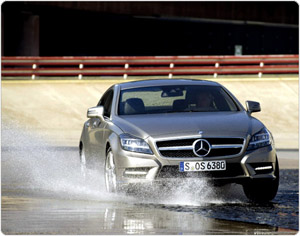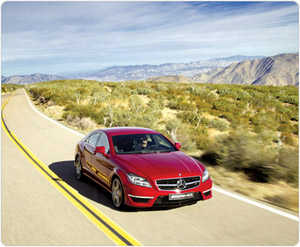On the road to accident-free driving
 Mercedes-Benz
is the pioneer of automotive safety. No other car manufacturer carries
out such intensive research in this field and has brought so many
crucial innovations onto the market. Ever since the invention of the
motor car in 1886, Mercedes-Benz has been instrumental in the
development of active and passive safety, setting one new benchmark
after another in the process. Mercedes-Benz
is the pioneer of automotive safety. No other car manufacturer carries
out such intensive research in this field and has brought so many
crucial innovations onto the market. Ever since the invention of the
motor car in 1886, Mercedes-Benz has been instrumental in the
development of active and passive safety, setting one new benchmark
after another in the process.
Today, accident-free driving ranks as one of the most important
objectives that the researchers and developers at Mercedes-Benz are
working to fulfil. Many of the innovations first introduced by
Mercedes-Benz have since become industry standards - from the rigid
passenger compartment (patented in 1951, first implemented in series
production in the 111-series "Fintail" models in 1959), to the ABS
anti-lock braking system (introduced in 1978 in the 116-series S-Class)
and the airbag (premiered in the 126-series S-Class from 1981), to the
ESP(r) Electronic Stability Program (presented in 1995 in the S-Class
Coupé from the 140 model series).
These days, such safety systems are standard fare for nearly all
manufacturers. This means that, in a way, there is a bit of
Mercedes-Benz in every modern-day motor car.
And the innovative solutions in every new model the brand brings out
show how vehicle safety will continue to be a matter of the highest
priority for Mercedes-Benz engineers in future too.
|
Later, the safety
experts at Mercedes-Benz started to devote their attention
increasingly to active safety by developing innovations designed
to mitigate the severity of collisions or prevent them from
occurring at all – to the benefit of all involved. Along the
road to accident-free driving, Mercedes-Benz became the first
car maker in the world to network active and passive safety
features with one another. |
The overriding goal is to continually reduce the number of road
traffic deaths and injuries and prevent accidents from happening in the
first place. When Mercedes-Benz's systematic program of safety research
first began, the focus was initially placed on passive safety, meaning
protecting the vehicle occupants as best possible in the event of an
accident.
Later, the safety experts at Mercedes-Benz started to devote their
attention increasingly to active safety by developing innovations
designed to mitigate the severity of collisions or prevent them from
occurring at all - to the benefit of all involved.
Along the road to accident-free driving, Mercedes-Benz became the
first car maker in the world to network active and passive safety
features with one another. With the anticipatory occupant protection
system PRE-SAFE(r), the Stuttgart brand opened up another new chapter in
the evolution of safety technology.
These days, it is the phase prior to an accident especially which
offers new safety-enhancing potential, as the more time there is between
detection of an impending collision and the actual impact, the more the
safety systems are able to increase the protection afforded to
occupants. Not long after the invention of the motor car, Carl Benz and
Gottlieb Daimler get to work on making the vehicles they developed ever
safer.
The Mercedes 35 hp dating from 1901 continues to serve as an
outstanding example of active safety today. Some of its design features
can still be found in modern-day vehicles, such as the long wheelbase,
the large track width and the low centre of gravity.
 Another
driving safety milestone is reached in 1931 with the 170 model, the
first ever production passenger car to combine independent suspension at
the front and rear with a hydraulic braking system. Another
driving safety milestone is reached in 1931 with the 170 model, the
first ever production passenger car to combine independent suspension at
the front and rear with a hydraulic braking system.
And with the double-wishbone front suspension in the Mercedes-Benz
380 in 1933, a standard of wheel suspension technology is introduced
that still holds good today, and has increased active safety
considerably.
Mercedes-Benz engineers start to take a methodical and analytical
approach to vehicle safety long before they have electronic tools to
help them. In parallel to this, Mercedes-Benz presses ahead with its
fundamental research in order to better understand the processes that
occur in a few fractions of a second in an accident. In 1939, a test
vehicle is created at Mercedes-Benz with a highly rigid floor assembly
including sturdy side impact protection, as well as a three-part
steering column. These design principles are incorporated into series
production in 1953 for the new Mercedes-Benz 180 "Ponton".
In the late 1940s, Béla Barényi - an engineer employed at the then
Mercedes-Benz AG - formulates the basic principles for the revolutionary
concept of a body with crumple zones, i.e. deformable sections at the
front and rear, which is then patented in 1952.
Barényi is the first to realise that the kinetic energy released in
an impact must be dissipated by deformation to protect the occupants
effectively. Consequently, he divides the vehicle body into three zones:
soft front section, rigid passenger compartment, soft rear section.
Accident-free driving remains an ambitious goal for the future.
The quest for accident-free driving poses a multifaceted and, above
all, ongoing challenge: the aim of the engineers will always be to make
the next generation of vehicles safer than the last, while also reacting
to the evolution of the complex machine that is the motor car and to
changes on our roads. |

